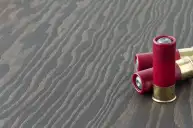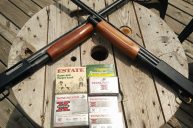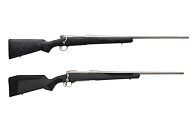Here's all the basics you need to know about hunting with shotgun slugs
For folks who are new to shotgunning, it can be a bit daunting considering the amount of information to consume and understand. There's a lot of terminology to learn on the gun side, and a whole lot more to learn on the ammo side, simply because shotgun ammo is so diverse, even within bores.
Shotgun slugs are basically large bullets fired from a shotgun. They are solid projectiles instead of little pellets of lead like buckshot or birdshot, and they strike with great force and have limited ranges—though with modern guns and slug design, that max range has been increased from about 50 to 100 yards max a few decades ago to getting super tight groups at 200 yards.
Slugs are used for hunting medium-sized game, especially whitetail deer hunting, and especially in areas that are too densely populated for rifle hunting. Slugs work well in these spots because of their limited range.
Today, there are two basic types of shotgun slugs, rifled slugs and sabot slugs.
Rifled Slugs

Getty Images: Sithawit+hongthrong
As you might have guessed from the name, rifled slugs have angled grooves cut into the sides of the projectile. You will sometimes see these called Foster Slugs, as they were invented by a cat named Karl Foster. The idea is that, when fired through smoothbore shotgun barrels, they will spin a bit and therefore be more accurate. Unfortunately, it has been proven that not only do rifled slugs not mimic the spin from a barrel with rifling, but they actually don't even spin enough to impact accuracy at all.
What the grooves actually do is reduce friction and allow the projectile to fit through different sized choke tubes. Accurate shots are limited to about 50 yards depending on various variables like gauge, load, and barrel length.
Generally, and paradoxically, you should avoid using rifled slugs in rifled shotgun barrels. This is not to say they are an ineffective form of slug. In places like Michigan, smoothbore guns like the Remington 870 and Winchester 1300 using foster-style slugs have probably killed more whitetails than any other weapon legal to use in the state. Just know you will not be able to reach out and tap that buck at long range.
Sabot Slugs
That brings us to sabot slugs. Yes, shotgun barrels with rifled bores are meant for slugs and slugs only. Specifically, they're made to work with sabot slugs.
Solid slugs are fitted inside a plastic cylinder that covers everything but the tip. This cylinder is the sabot. Some projectiles are hollow points. Think of it like a shot cup and wad. The sabot and projectile both are loaded into the shotgun shell. When fired, the plastic sabot catches the rifling, which imparts spin to the slug, greatly increasing stabilization as it flies. When the slug leaves the muzzle, the sabot falls away and the slug continues on, maintaining that spin.
This increased accuracy dramatically as well as the effective range of the slug. My Savage 220 bolt action slug gun can routinely print 20-gauge slug holes in 3-inch groups at 200 yards with the right scope.
While you should only use sabot slugs in rifled barrels, you can also run them through a smoothbore. It's kind of a waste, since saboted slug shotshells are generally more expensive and they aren't any more accurate through smoothbore than a rifled slug is.
As a rule of thumb, slugs work best with an open or cylinder bore or cylinder choke tubes. While they can be fired through other choke sizes like Improved Cylinder, you should never fire slugs of any kind through full chokes or extra full chokes.
As an additional note, don't fire shot through a rifled barrel. It could potentially damage the rifling over time, but it will also cause the shot to spin a bit, which will make patterns open up much faster after leaving the muzzle.
A pump action slug gun works pretty good, but to get the most accuracy out of your saboted rounds, a bolt action is really the way to go.
Here are some great slug options for deer and similar sized game:
Browning Rifled Slug
Expect around 1,600 fps from these 2.75-inch foster-style slugs. They fly well out of smoothbore barrels and are available in 12- and 20-gauge
Federal Trophy Copper Sabot Slug
These sabots feature a polymer tip and can reach a muzzle velocity of 1,900 fps. Federal says you can get sub four-inch groups at 200 yards with these. Available in 12 gauge and 20 gauge
Brenneke Black Magic Magnum
These 12 gauge, 3" magnum with 602-grain rifled slugs are hard hitters for dangerous game. Expect 1,500 fps speeds and up to 1,200 pounds of energy to the target at 100 yards.
Hornady SST Sabot Shotgun Slugs
Includes Hornady Flex Tip technology for increased accuracy. Available in 12 and 20 gauge with various slug weights.
Products featured on Wide Open Spaces are independently selected by our editors. However, when you buy something through our links, we may earn a commission.
NEXT: THE AXIS DEER AND HOW THEY'RE IMPACTING PARTS OF THE UNITED STATES
WATCH






